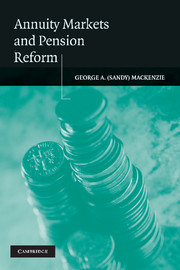Book contents
- Frontmatter
- Contents
- List of Tables
- Acknowledgments
- Introduction
- PART ONE
- PART TWO
- 5 Individual Liberty versus Security in Retirement, and the Government's Role
- 6 Policy Issues with Both Public and Private Sector Provision of Mandatory Annuities
- 7 Policy Issues with Privatization of the Provision of Annuities
- 8 Conclusions and Recommendations
- Appendix 1 The Economics and Financing of Annuities
- Appendix 2 Aging and Its Impact on Pension Systems
- Glosssary
- References
- Index
8 - Conclusions and Recommendations
Published online by Cambridge University Press: 13 November 2009
- Frontmatter
- Contents
- List of Tables
- Acknowledgments
- Introduction
- PART ONE
- PART TWO
- 5 Individual Liberty versus Security in Retirement, and the Government's Role
- 6 Policy Issues with Both Public and Private Sector Provision of Mandatory Annuities
- 7 Policy Issues with Privatization of the Provision of Annuities
- 8 Conclusions and Recommendations
- Appendix 1 The Economics and Financing of Annuities
- Appendix 2 Aging and Its Impact on Pension Systems
- Glosssary
- References
- Index
Summary
The book began by posing three basic questions. What should the policy toward distributions from individual accounts be – in particular, how restrictive should the rules applying to annuities or distributions in other forms be? Should annuities, if they are mandatory, be supplied by the public or the private sector? How can markets for voluntary annuities be made more efficient, and their effective regulation ensured? This concluding chapter proposes answers for each of them.
POLICY ISSUES WITH EITHER PUBLIC OR PRIVATE PROVISION OF MANDATORY ANNUITIES
Distributions before retirement and bequests
Chapter 4 noted that countries that have adopted individual accounts, whether to complement or replace an existing pay-as-you-go (PAYG) system, have taken the position that individual accounts do not enjoy the same legal status as holdings of other financial assets. Specifically, they are not endowed with the same complement of property rights. Instead, existing individual accounts systems treat individual accounts exclusively as a source of income for retirement. In virtually no country are withdrawals allowed while the account holder is still alive, whether they are intended to finance an education or the purchase of a house, pay medical bills, or tide the account holder over a spell of unemployment. In Chile, the balance in individual accounts at the death of the holder is inheritable, but only under certain conditions.
- Type
- Chapter
- Information
- Annuity Markets and Pension Reform , pp. 177 - 193Publisher: Cambridge University PressPrint publication year: 2006



